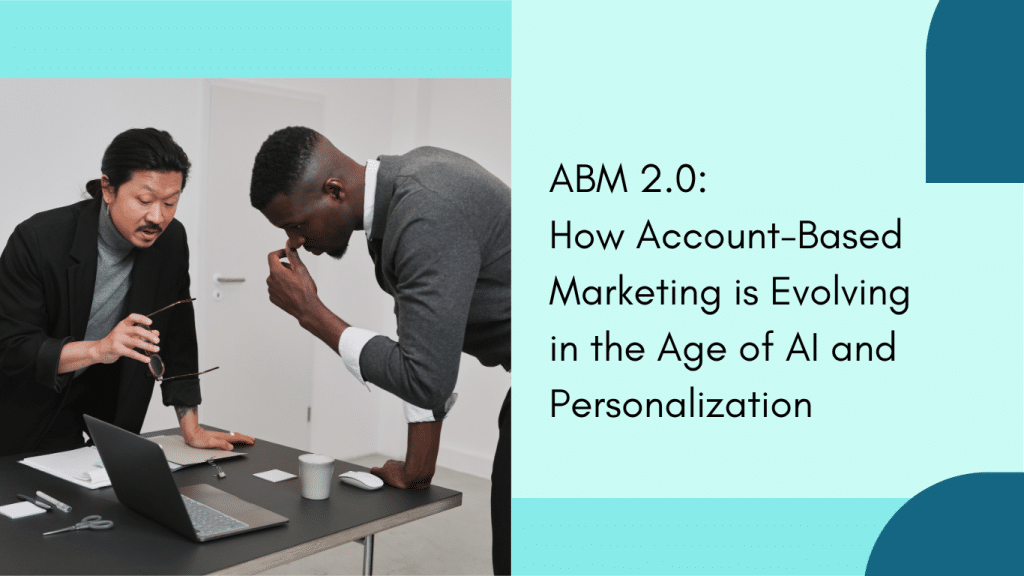The Rise of ABM 2.0 in a Data-Driven Era –
Account-Based Marketing (ABM) has long been a cornerstone strategy in the B2B industry, enabling businesses to focus on high-value accounts rather than casting wide, unfocused marketing nets. However, with the explosion of data, advanced analytics, and artificial intelligence (AI), traditional ABM methods are being reimagined. What we now call ABM 2.0 is a smarter, scalable, and more personalized approach to B2B marketing — driven by real-time insights and automation.
ABM 2.0 is more than just a technological upgrade; it represents a mindset shift. Rather than relying solely on historical sales data and manual research, marketers can now use AI tools to proactively identify in-market accounts, understand their intent signals, and engage them at the right moment with the right message.
Key Drivers Behind ABM 2.0:
- Increasing buyer expectations for personalized experiences
- Advances in AI, ML, and natural language processing
AI-Powered Targeting: Smarter Than Ever –
In ABM 2.0, identifying the right accounts is no longer based on guesswork or static firmographics alone. AI and predictive analytics help marketers identify potential buyers based on intent signals, website behavior, third-party data, and past engagement history. These tools enable hyper-targeted outreach to those who are actively researching or showing signs of purchase readiness.
Instead of manually building account lists, B2B marketers can now let machine learning algorithms analyze patterns across millions of data points to prioritize the accounts most likely to convert. This leads to better alignment between marketing and sales, and more efficient use of resources.
How AI Enhances Targeting:
- Predictive scoring of high-value accounts
- Real-time intent signal tracking from 3rd-party sources
- CRM and behavioral data integration for 360° view
- Dynamic segmentation based on engagement
Personalization at Scale: Moving Beyond First Names –
One of the biggest challenges in traditional ABM was personalization at scale. With ABM 2.0, AI helps marketers move beyond surface-level personalization to deliver content and messaging that’s deeply relevant to each account’s industry, pain points, and stage in the buying journey.
Content engines powered by machine learning can automatically tailor emails, landing pages, and ads to match the specific needs of an account. Marketers can now speak to multiple stakeholders within the same company with unique, role-specific messaging — without creating everything manually.
Examples of Scalable Personalization Tactics:
- Dynamic landing pages based on firmographic or intent data
- Personalized ad retargeting campaigns by job role or industry
- Automated email sequences based on behavioral triggers
- Content recommendations tailored to account interest
Unified Data & Sales Alignment: Breaking Silos –
ABM 2.0 thrives on the seamless integration of data across platforms — from CRM to marketing automation to customer success tools. AI tools don’t just collect data; they interpret it, highlight meaningful insights, and allow teams to act in real-time.
Sales and marketing teams are no longer working in silos. ABM 2.0 encourages tighter alignment by providing both sides with unified dashboards, real-time account intelligence, and synchronized outreach strategies. This collaboration ensures no opportunity is lost in handoffs and engagement is consistent from the first touchpoint to deal closure.
Key Features That Support Alignment:
- Shared dashboards with account-level engagement data
- Lead-to-account matching powered by AI
- Real-time Slack or email alerts for buyer activity
Measurement & Optimization in ABM 2.0 –
Measuring the success of ABM campaigns has always been a complex task. ABM 2.0 introduces sophisticated attribution modeling and performance tracking to truly understand what’s working. AI-driven analytics platforms help marketers determine which messages, channels, and tactics are influencing pipeline and revenue.
Beyond standard KPIs like open rates and impressions, ABM 2.0 focuses on account engagement scores, buying group behaviors, and deal acceleration metrics. These insights help teams continually test, learn, and optimize campaigns to improve ROI over time.
Modern ABM Metrics to Track:
- Account engagement score (multi-channel)
- Pipeline velocity and influence
- Number of stakeholders engaged per account
Conclusion –
In the era of AI and hyper-personalization, ABM 2.0 isn’t just an optional upgrade — it’s becoming a necessity for B2B organizations that want to stay competitive. By leveraging artificial intelligence, real-time intent data, and scalable personalization, marketers can craft more relevant, effective, and efficient campaigns that truly resonate with decision-makers.
As buyer journeys become more complex and digital-first, the companies that master ABM 2.0 will be the ones driving better alignment, deeper engagement, and ultimately, higher revenue. The future of B2B marketing is account-based — but smarter, faster, and more human than ever before.

